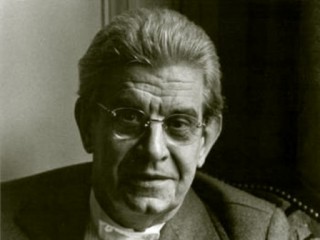
Jacques Lacan (En.) biography
Date of birth : 1901-04-13
Date of death : 1981-09-09
Birthplace : Paris, France
Nationality : French
Category : Science and Technology
Last modified : 2011-07-04
Credited as : Pshychiatrist, psychoanalist,
Jacques Lacan was born in Paris on April 13, 1901, the eldest child of Emilie and Alfred Lacan, a representant de commerce dealing in soap and oils. The family belonged to the prosperous middle bourgeoisie, and Lacan went to the Collège Stanislas, a well-known Jesuit establishment. Too thin to be accepted into military service, he went straight to the study of medicine and then to psychiatry. He took his clinical training at Sainte-Anne, the major psychiatric hospital in central Paris.
In 1931 he received his license as a forensic psychiatrist, and in 1932 was awarded his Doctorat d'etat for his thesis, De la Psychose paranoiaque dans les rapports avec la personnalite. While this thesis drew considerable acclaim outside psychoanalytic circles, particularly among the surrealist artists, it seems to have been ignored by psychoanalysts. But in 1934 he became a candidate for the Societe Psychanalytique de Paris. During this period he is said to have befriended the surrealists Andre Breton and Georges Bataille. Because Lacan, like Freud, apparently destroyed most of the records of his past, and unlike Freud did not reveal much of it later on, it is difficult to distinguish between the many myths, anecdotes, and rumors that have surrounded him. There are, for instance, many contradictory tales about his romantic life with Sylvia Bataille in southern France during World War II and of his attachment to her daughter Laurance. He married Sylvia in 1953 and had another daughter, Judith, whose husband Jacques-Alain Miller served as Lacan's literary executor.
In 1934 Lacan developed the first version of his "mirror stage," which was to become the cornerstone of his theory when presented at the meetings of the International Psychoanalytic Association two years later in Marienbad. Due to World War II and the decimation of psychoanalysis on the Continent, Lacan's ideas lay dormant until 1949. Then he presented a more complex and complete variant of his "mirror stage" theory. Extrapolating from his work with patients, he maintained that the child's first perception of itself in the mirror, how it becomes aware of itself as a biological organism, sets the stage for its future psychic development. During this stage (from about six to eighteen months) the child realizes that its parents are not totally responsive to inarticulate demands, that it has to acquire language. And what happens during this process determines psychic development.
Lacan's Freudian peers did not appreciate his contributions. In fact, the so-called American ego psychologists, who held that infantile experiences are being resolved during the oedipal period, could not accept Lacan's "rereading of Freud." They mandated different types of interactions between analyst and patient, different assumptions about human growth and about the structure of the unconscious.
Lacan and his peers in the International Psychoanalytic Association eventually split up, in 1953, because they could not agree on how best to help patients reach and then overcome early unconscious trauma. Classical psychoanalysts were agreed that, optimally, this could happen only by means of regular sessions, four to five times a week, for at least 45 minutes, and over a period of around four years. Lacan was seeing his patients once or twice a week, for five to 25 minutes, and attacking his American and Parisian adversaries as authoritarian. However, a part of these attacks was incorporated in his theories when he played on, for instance, such terms as the nom du pere and the non du pere to accuse the "sons of Freud"—that is, the leaders in the psychoanalytic movement—of paternalism and of domination counterproductive to the relationship between psychoanalyst and analysand.
Lacanian psychoanalytic theory differentiated itself also by underpinning it with Ferdinand de Saussure's structural linguistics—which in the 1960s was inspiring the other leading "structuralists," Michel Foucault, Roland Barthes, Louis Althusser, and Claude Levi-Strauss. They all set out to uncover systematically the deep universal mental structures that manifest themselves in language. And they expected to find them by unveiling the relationships between signs (concepts) and signifiers (acoustic images); between language and words; and by studying their changing meanings. Lacan concentrated on "the language of the unconscious," not only in his work with patients but in the public seminars which certainly helped make him central to Parisian intellectual life, along with psychoanalysis, from the late 1960s until long after he died in 1981.
Lacan's analysis of literary texts as well used Saussurean means of "rereading." Whereas Freud and his followers (both literary figures and psychoanalysts) in a way were "diagnosing" artists and their works, Lacan's technique introduced a new dimension. His own imagination coupled to the linguistic method allowed him to make all sorts of jumps, in both metaphoric and metonymic directions. His famous seminar on Poe's "Purloined Letter" particularly intrigued American literary critics.
Lacan always deemed the psychoanalytic relationship central to everything he did. When he stated, for instance, that psychoanalysis is "structured like a language," he referred to the interaction between the analyst's and his patient's unconscious. His American followers, however, primarily were located in universities and, for the most part, ignored the therapeutic realm. Consequently, his Parisian adherents tended to be therapists working with patients who disregarded American textual analyses.
Urbane, brilliant, and provocative, Lacan continued to influence French intellectual life even while his ideas were questioned and debated.
















